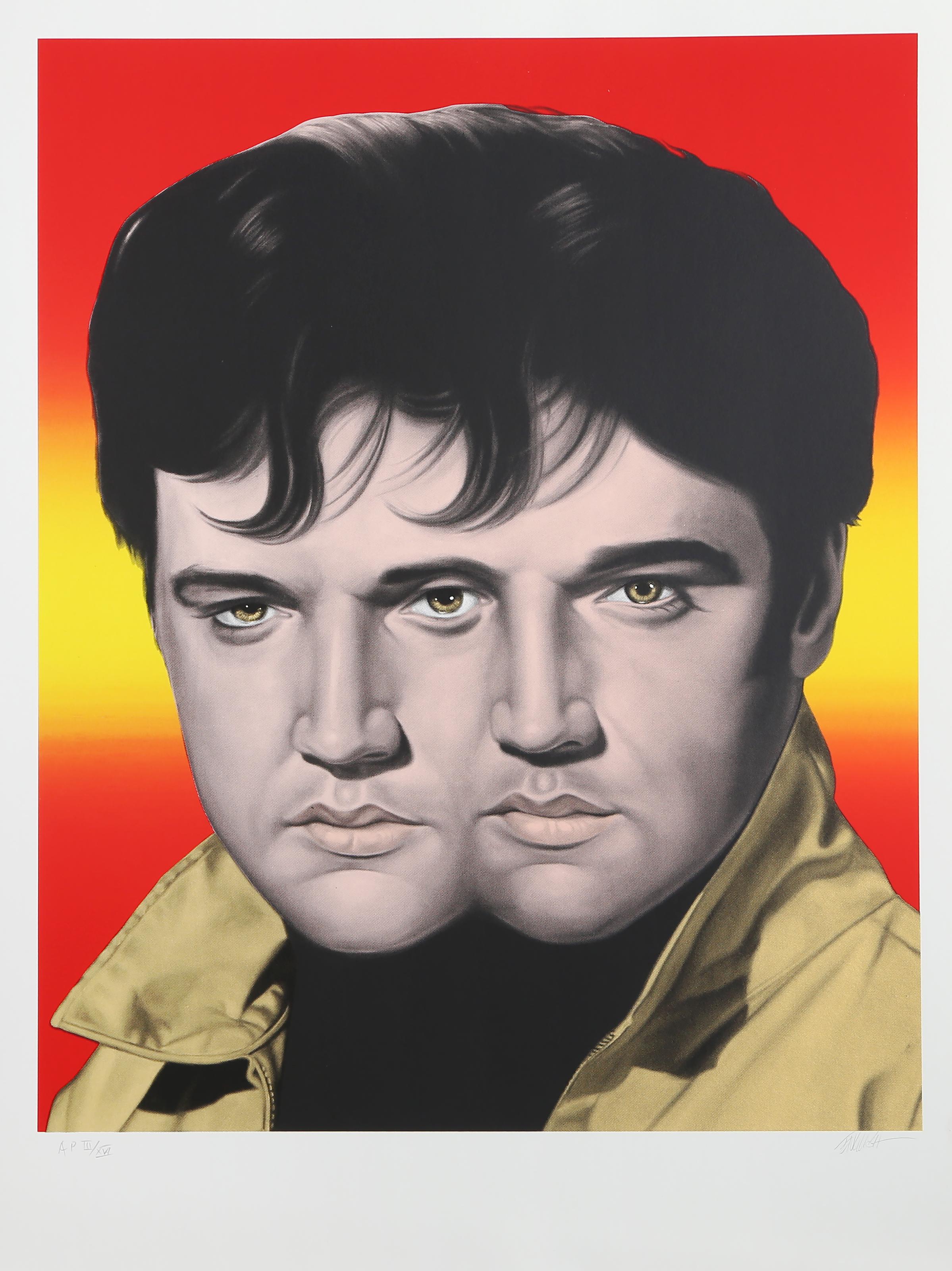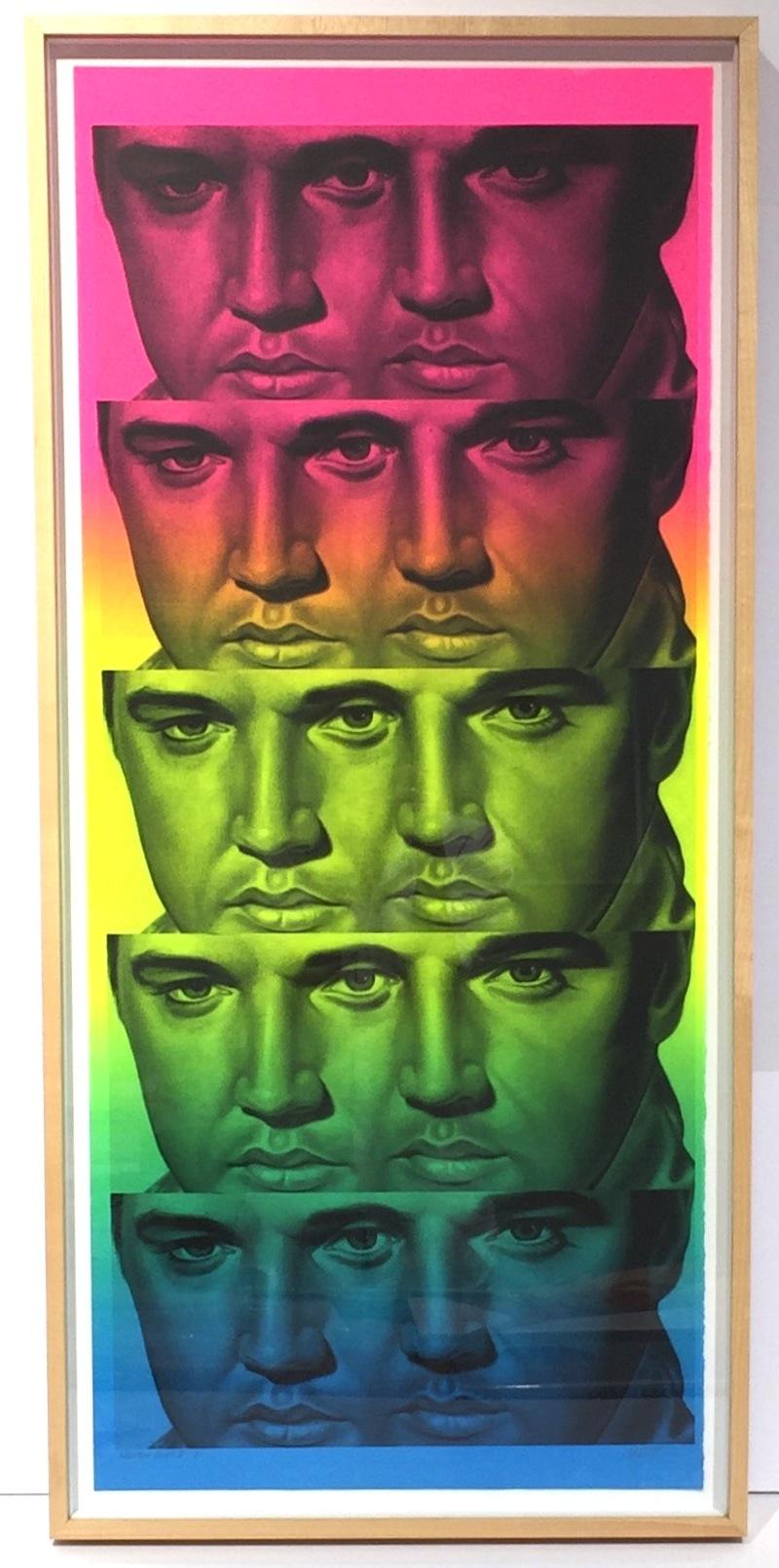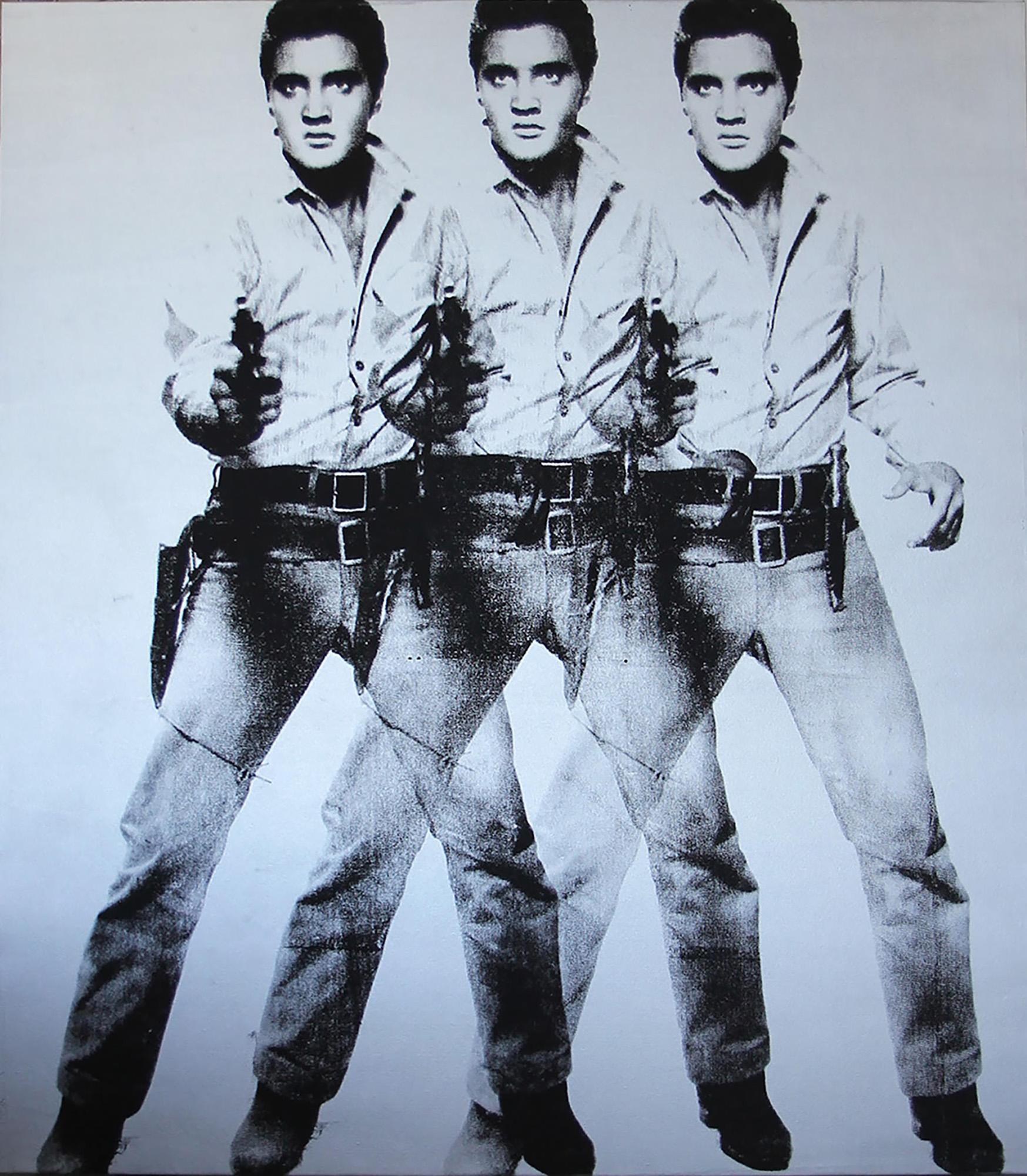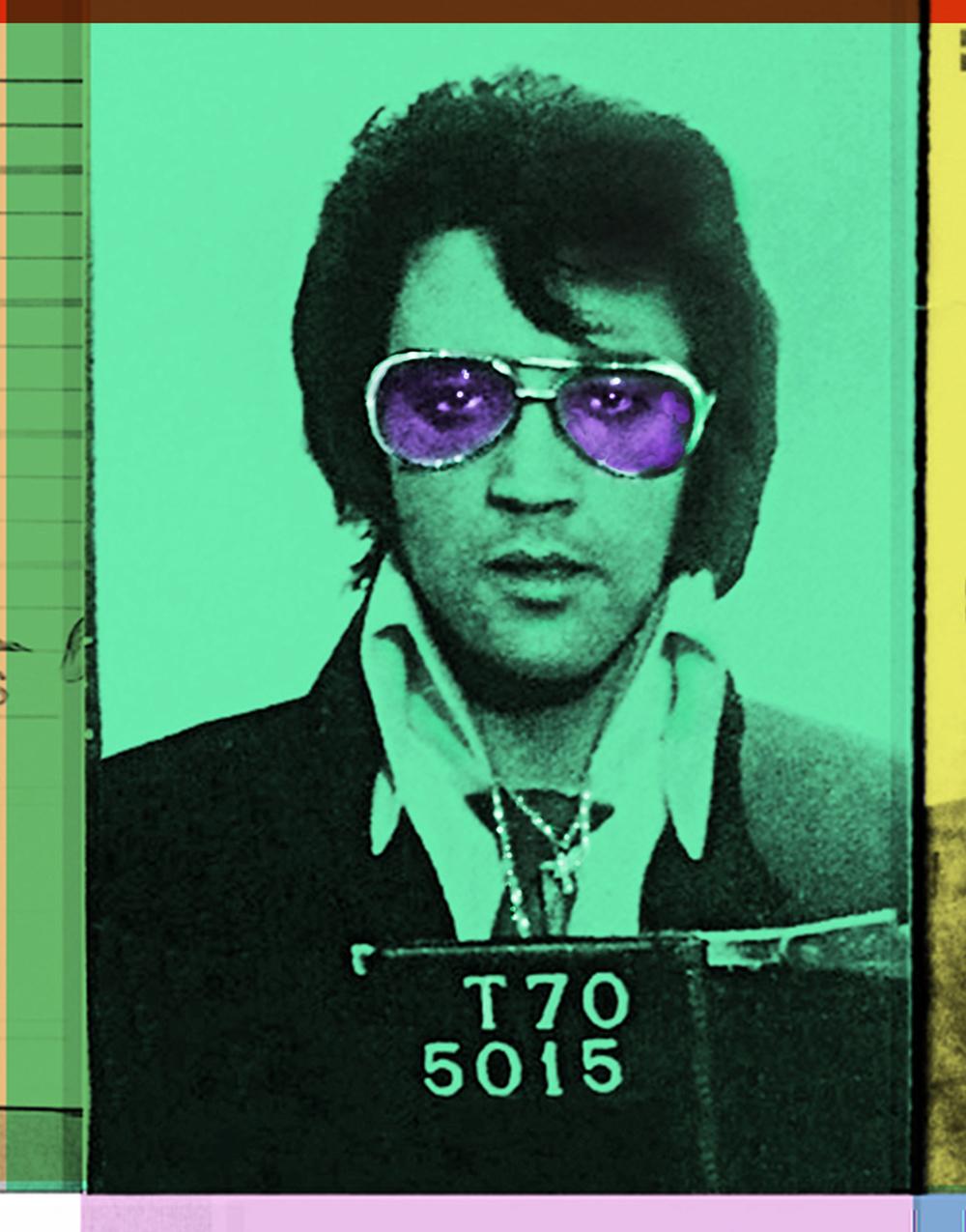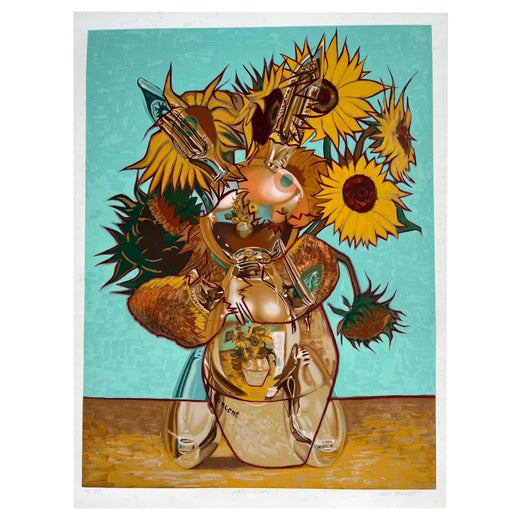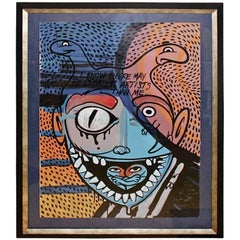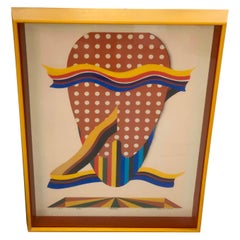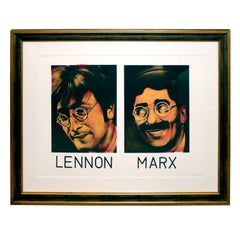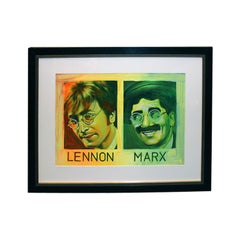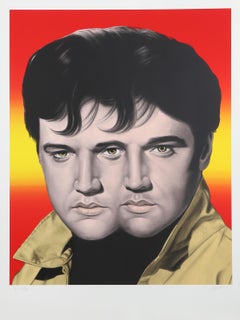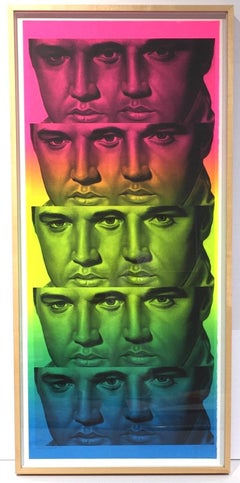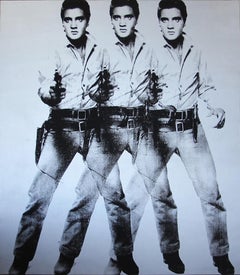Items Similar to Ron English Pop Elvis/Elvis in Purple and Orange
Want more images or videos?
Request additional images or videos from the seller
1 of 18
Ron English Pop Elvis/Elvis in Purple and Orange
$3,500
£2,657.63
€3,039.20
CA$4,890.01
A$5,438.76
CHF 2,839.95
MX$66,183.87
NOK 36,270.49
SEK 34,015.32
DKK 22,682.73
Shipping
Retrieving quote...The 1stDibs Promise:
Authenticity Guarantee,
Money-Back Guarantee,
24-Hour Cancellation
About the Item
A great image by the noted Pop Artist Ron English. This work is a c print on Canvas. Title on the back and signed Elvis Elvis Purple Orange, Orange Purple. It is also signed English. Measures 36x36 inches. The work is wonderfully evocative and very much in Ron English’s Popaganda style. Please have a look at some of the other works by the artist we have listed on this site of , including 2 Lennon and Marx paintings. This work is not framed and wraps around the edges as left by the artist. It is in good condition although i noticed a minuscule spot with some black touch up pictured.
From the artist’s website:
One of the most prolific and recognizable artists alive today, New York-based painter, street artist and designer Ron English has bombed the global landscape with unforgettable images across all categories of culture, history and art. As a fine art painter enjoying gallery and museum representation worldwide, Mr. English is well-known for his stunning oil technique and inventive use of color.
Widely considered the Godfather of Street Art, he has created murals and billboards across the globe that blend dazzling visuals with biting political, consumerist and surrealist statements. Mr. English has also been on the vanguard of the booming vinyl art figure movement, releasing hundreds of unique and highly coveted collectibles that continue to fetch healthy aftermarket prices.
Publications featuring Mr. English include The New York Times, The Wall Street Journal, USA Today, The Miami Herald, The Washington Post, The Los Angeles Times, LA Weekly, Art News, Time Magazine, Rolling Stone, Creem, Juxtapoz Magazine, Hi Fructose, Mad Magazine and many others.
Motion picture/television appearances include Exit through the Gift Shop, Supersize Me, The Simpsons, Work of Art, Street Art Throwdown, CNN, BBC, Sky TV, and many others.
- Creator:Ron English (Artist)
- Dimensions:Height: 36 in (91.44 cm)Width: 36 in (91.44 cm)Depth: 1.5 in (3.81 cm)
- Materials and Techniques:
- Place of Origin:
- Period:
- Date of Manufacture:2008
- Condition:Wear consistent with age and use. Minor losses. It is in good condition although i noticed a minuscule spot with some black touch up pictured.
- Seller Location:Palm Springs, CA
- Reference Number:1stDibs: LU835040074972
Ron English
Ron English (b. 1959) is a pioneering American contemporary artist who explores the intersection of street art, brand imagery, superhero comics, art history, advertising, and politics. His cheeky interpretation of Pop Art comes alive in vibrant drawings, paintings, and murals. English’s imagery is found on the street, in museums, in movies, books, and television. His irreverent, imagined characters include MC Supersized, the obese fast-food mascot featured in Morgan Spurlock’s 2004 documentary Super Size Me, and Abraham Obama, a mischievous hybrid of the 16th and 44th U.S. presidents. Sociocultural commentary underscores his work, exemplified by his iteration of Ronald McDonald as a western culture “Buddha” gorging McDonald’s to expose the insatiable slothfulness of consumerism. English transformed his early experience as an art reproducer to become a founding co-creator of illegal public art campaigns in the early 1980s. His controversial street art activities are the subject matter and explored extensively in POPaganda - The Art & Crimes of Ron English, a documentary directed by Pedro Carvajal. An acclaimed outlaw artist, English never became an official member, but he has participated with the Billboard Liberation Front, which practices culture jamming by altering billboards to change keywords and radically alter the message, often to make an anti-corporate statement. He frequently targets corporations and their mascots, including Joe Camel and Mickey Mouse. English seeks to inspire people to question consumer capitalism through his exaggerated, grotesque characters. English is a masterful oil painter working in a photorealist style. After earning a Bachelor of Fine Arts from the University of North Texas in Denton, and an MFA from The University of Texas, English moved to New York City, where he apprenticed with several artists and started selling his own work. English reworks art historical imagery, such as depictions of Picasso’s Guernica, as a template to explore universal issues. English’s work is in the permanent collections of the Museum of Modern Art, Paris, the Whitney Museum of Modern Art in New York, and the Paterson Museum in Paterson, New Jersey. He has exhibited at the Station Museum in Houston and the Museum of Contemporary Art, Washington DC. In November of 2021, English’s enormous immersive installation Sugar Circus opened an exhibition at The Nest in Q Plex in Nanshan District in Shenzhen, China. His work has been featured in solo and group shows around the world.
About the Seller
5.0
Platinum Seller
Premium sellers with a 4.7+ rating and 24-hour response times
1stDibs seller since 2007
415 sales on 1stDibs
Typical response time: <1 hour
- ShippingRetrieving quote...Shipping from: Palm Springs, CA
- Return Policy
Authenticity Guarantee
In the unlikely event there’s an issue with an item’s authenticity, contact us within 1 year for a full refund. DetailsMoney-Back Guarantee
If your item is not as described, is damaged in transit, or does not arrive, contact us within 7 days for a full refund. Details24-Hour Cancellation
You have a 24-hour grace period in which to reconsider your purchase, with no questions asked.Vetted Professional Sellers
Our world-class sellers must adhere to strict standards for service and quality, maintaining the integrity of our listings.Price-Match Guarantee
If you find that a seller listed the same item for a lower price elsewhere, we’ll match it.Trusted Global Delivery
Our best-in-class carrier network provides specialized shipping options worldwide, including custom delivery.More From This Seller
View AllRon English Abstract Acrylic over a Peter Max Silkscreen
By Ron English
Located in Palm Springs, CA
A great image this Ron English work is a Peter Max silkscreen with acrylic paint over it. It reads "I know there may be greater artists than me, b...
Category
Late 20th Century American Paintings
!969 Pop Art Lithograph by Ken Kusaka
By Ken Kusaka
Located in Palm Springs, CA
A vibrant 1969 lithograph by Ken Kusaka. Signed numbered and dated lower margin. In a period shadow box. Frame has some age wear and paint loss. Litho is in good condition.
Category
Vintage 1960s American Paintings
Materials
Paper
$2,000 Sale Price / item
20% Off
Paint on Paper by Ron English of John Lennon and Groucho Marx
By Ron English
Located in Palm Springs, CA
A wonderful painting on a silkscreen signed Ron English of John Lennon and Groucho Marx.
The painting is in good condition. The frame has a few nicks and chips, some small spots of r...
Category
Late 20th Century American Paintings
Materials
Paint
$4,750 Sale Price
50% Off
Painted Silkscreen of John Lennon & Groucho Marx by Ron English
By Ron English
Located in Palm Springs, CA
A silkscreen on paper that has been painted over in acrylic or oil. It was done by Ron English as we have the same image signed done in different styles. This one is not signed or ma...
Category
Late 20th Century American Outsider and Self Taught Art
Joshua Jenkins 2014 "Hanging with Jesus" Large Abstract
By Joshua Jenkins
Located in Palm Springs, CA
A quite impressive large abstract by the noted artist Joshua Jenkins, done in 2014 and titled on the back "Hanging with Jesus" Some minor paint loss, but in good condition.
The paint...
Category
2010s American Modern Paintings
Materials
Paint
$7,200 Sale Price
20% Off
"Baby" by Robert Kushner, 1978
By Robert Kushner
Located in Palm Springs, CA
Watercolor on paper by the noted artist Robert Kushner. It is on 3 pieces of paper affixed to a board backing. Signed and dated 1978 lower right and titled "Baby" lower left. Origina...
Category
Vintage 1970s American Paintings
Materials
Paint
$3,300 Sale Price
40% Off
You May Also Like
Red Elvis, Screenprint by Ron English
By Ron English
Located in Long Island City, NY
Portfolio: Urban Pop Portfolio (1972-2012)
Date: 2012
Screenprint, signed and numbered in pencil
Edition of AP III/XVI
Image Size: 32.75 x 26.5 inches
Size: 39 x 29.5 in. (99.06 x 74...
Category
2010s Pop Art Prints and Multiples
Materials
Screen
Rainbow Elvis II
By Ron English
Located in Miami, FL
TECHNICAL INFORMATION
Ron English
Rainbow Elvis II
2012
Monoprint Hand-painted Screenprint with Watercolor Dyes
37 1/2 x 17 in.
Unique
Pencil signed & numbered
Accompanied wi...
Category
2010s Street Art Prints and Multiples
Materials
Screen
"Elvis", Pop Art Print by Erró
By Erró
Located in Long Island City, NY
Artist: Gudmundur Erro, Icelandic (1932 - )
Title: Elvis
Year: 2005
Medium: Lithograph, signed and numbered in pencil
Edition: 180
Image Size: 17.25 x 24 inches
Size: 23 x 31.5 in. (...
Category
Early 2000s Pop Art Figurative Prints
Materials
Lithograph
"Triple Elvis" Denied Andy Warhol Silver Black Pop Art Painting by Charles Lutz
By Charles Lutz
Located in Brooklyn, NY
"Triple Elvis" (Denied) Silkscreen Painting by Charles Lutz
Silkscreen and silver enamel paint on canvas with Artist's Denied stamp of the Andy Warhol Art Authentication Board.
82 x 72" inches
2010
This important example was shown alongside works by Warhol in a two-person show "Warhol Revisited (Charles Lutz / Andy Warhol)" at UAB Abroms-Engel Institute for the Visual Arts in 2024.
Lutz's 2007 ''Warhol Denied'' series gained international attention by calling into question the importance of originality or lack thereof in the work of Andy Warhol. The authentication/denial process of the [[Andy Warhol Art Authentication Board]] was used to create value by submitting recreations of Warhol works for judgment with the full intention for the works to be formally marked "DENIED". The final product of the conceptual project being "officially denied" "Warhol" paintings authored by Lutz.
Based on the full-length Elvis Presley paintings by Pop Artist Andy Warhol in 1964, this is likely one of his most iconic images, next to Campbell's Soup Cans and portraits of Jackie Kennedy, Marilyn Monroe, Liz Taylor, and Marlon Brando. This is the rarest of the Elvis works from the series, as Lutz sourced a vintage roll of 1960's primed artist linen which was used for this one Elvis. The silkscreen, like Warhol's embraced imperfections, like the slight double image printing of the Elvis image.
Lutz received his BFA in Painting and Art History from Pratt Institute and studied Human Dissection and Anatomy at Columbia University, New York. Lutz's work deals with perceptions and value structures, specifically the idea of the transference of values. Lutz's most recently presented an installation of new sculptures dealing with consumerism at Frank Lloyd Wright's Fallingwater House in 2022.
Lutz's 2007 Warhol Denied series received international attention calling into question the importance of originality in a work of art. The valuation process (authentication or denial) of the Andy Warhol Art Authentication Board was used by the artist to create value by submitting recreations of Warhol works for judgment, with the full intention for the works to be formally marked "DENIED" of their authenticity. The final product of this conceptual project is "Officially DENIED" "Warhol" paintings authored by Lutz.
Later in 2013, Lutz went on to do one of his largest public installations to date. At the 100th Anniversary of Marcel Duchamp's groundbreaking and controversial Armory Show, Lutz was asked by the curator of Armory Focus: USA and former Director of The Andy Warhol Museum, Eric Shiner to create a site-specific installation representing the US. The installation "Babel" (based on Pieter Bruegel's famous painting) consisted of 1500 cardboard replicas of Warhol's Brillo Box (Stockholm Type) stacked 20 ft tall. All 1500 boxes were then given to the public freely, debasing the Brillo Box as an art commodity by removing its value, in addition to debasing its willing consumers.
Elvis was "the greatest cultural force in the Twentieth Century. He introduced the beat to everything, and he changed everything - music, language, clothes, it's a whole new social revolution." Leonard Bernstein in: Exh. Cat., Boston, The Institute of Contemporary Art and traveling, Elvis + Marilyn 2 x Immortal, 1994-97, p. 9.
Andy Warhol "quite simply changed how we all see the world around us." Kynaston McShine in: Exh. Cat., New York, Museum of Modern Art (and traveling), Andy Warhol: Retrospective, 1996, p. 13.
In the summer of 1963 Elvis Presley was just twenty-eight years old but already a legend of his time. During the preceding seven years - since Heartbreak Hotel became the biggest-selling record of 1956 - he had recorded seventeen number-one singles and seven number-one albums; starred in eleven films, countless national TV appearances, tours, and live performances; earned tens of millions of dollars; and was instantly recognized across the globe. The undisputed King of Rock and Roll, Elvis was the biggest star alive: a cultural phenomenon of mythic proportions apparently no longer confined to the man alone. As the eminent composer Leonard Bernstein put it, Elvis was "the greatest cultural force in the Twentieth Century. He introduced the beat to everything, and he changed everything - music, language, clothes, it's a whole new social revolution." (Exh. Cat., Boston, The Institute of Contemporary Art (and traveling), Elvis + Marilyn 2 x Immortal, 1994, p. 9).
In the summer of 1963 Andy Warhol was thirty-four years old and transforming the parameters of visual culture in America. The focus of his signature silkscreen was leveled at subjects he brilliantly perceived as the most important concerns of day to day contemporary life. By appropriating the visual vernacular of consumer culture and multiplying readymade images gleaned from newspapers, magazines and advertising, he turned a mirror onto the contradictions behind quotidian existence. Above all else he was obsessed with themes of celebrity and death, executing intensely multifaceted and complex works in series that continue to resound with universal relevance. His unprecedented practice re-presented how society viewed itself, simultaneously reinforcing and radically undermining the collective psychology of popular culture. He epitomized the tide of change that swept through the 1960s and, as Kynaston McShine has concisely stated, "He quite simply changed how we all see the world around us." (Exh. Cat., New York, Museum of Modern Art (and traveling), Andy Warhol: Retrospective, 1996, p. 13).
Thus in the summer of 1963 there could not have been a more perfect alignment of artist and subject than Warhol and Elvis. Perhaps the most famous depiction of the biggest superstar by the original superstar artist, Double Elvis is a historic paradigm of Pop Art from a breath-taking moment in Art History. With devastating immediacy and efficiency, Warhol's canvas seduces our view with a stunning aesthetic and confronts our experience with a sophisticated array of thematic content. Not only is there all of Elvis, man and legend, but we are also presented with the specter of death, staring at us down the barrel of a gun; and the lone cowboy, confronting the great frontier and the American dream. The spray painted silver screen denotes the glamour and glory of cinema, the artificiality of fantasy, and the idea of a mirror that reveals our own reality back to us. At the same time, Warhol's replication of Elvis' image as a double stands as metaphor for the means and effects of mass-media and its inherent potential to manipulate and condition. These thematic strata function in simultaneous concert to deliver a work of phenomenal conceptual brilliance. The portrait of a man, the portrait of a country, and the portrait of a time, Double Elvis is an indisputable icon for our age.
The source image was a publicity still for the movie Flaming Star, starring Presley as the character Pacer Burton and directed by Don Siegel in 1960. The film was originally intended as a vehicle for Marlon Brando and produced by David Weisbart, who had made James Dean's Rebel Without a Cause in 1955. It was the first of two Twentieth Century Fox productions Presley was contracted to by his manager Colonel Tom Parker, determined to make the singer a movie star. For the compulsive movie-fan Warhol, the sheer power of Elvis wielding a revolver as the reluctant gunslinger presented the zenith of subject matter: ultimate celebrity invested with the ultimate power to issue death. Warhol's Elvis is physically larger than life and wears the expression that catapulted him into a million hearts: inexplicably and all at once fearful and resolute; vulnerable and predatory; innocent and explicit. It is the look of David Halberstam's observation that "Elvis Presley was an American original, the rebel as mother's boy, alternately sweet and sullen, ready on demand to be either respectable or rebellious." (Exh. Cat., Boston, Op. Cit.). Indeed, amidst Warhol's art there is only one other subject whose character so ethereally defies categorization and who so acutely conflated total fame with the inevitability of mortality. In Warhol's work, only Elvis and Marilyn harness a pictorial magnetism of mythic proportions.
With Marilyn Monroe, whom Warhol depicted immediately after her premature death in August 1962, he discovered a memento mori to unite the obsessions driving his career: glamour, beauty, fame, and death. As a star of the silver screen and the definitive international sex symbol, Marilyn epitomized the unattainable essence of superstardom that Warhol craved. Just as there was no question in 1963, there remains still none today that the male equivalent to Marilyn is Elvis. However, despite his famous 1968 adage, "If you want to know all about Andy Warhol, just look at the surface of my paintings" Warhol's fascination held purpose far beyond mere idolization. As Rainer Crone explained in 1970, Warhol was interested in movie stars above all else because they were "people who could justifiably be seen as the nearest thing to representatives of mass culture." (Rainer Crone, Andy Warhol, New York, 1970, p. 22). Warhol was singularly drawn to the idols of Elvis and Marilyn, as he was to Marlon Brando and Liz Taylor, because he implicitly understood the concurrence between the projection of their image and the projection of their brand. Some years after the present work he wrote, "In the early days of film, fans used to idolize a whole star - they would take one star and love everything about that star...So you should always have a product that's not just 'you.' An actress should count up her plays and movies and a model should count up her photographs and a writer should count up his words and an artist should count up his pictures so you always know exactly what you're worth, and you don't get stuck thinking your product is you and your fame, and your aura." (Andy Warhol, The Philosophy of Andy Warhol (From A to B and Back Again), San Diego, New York and London, 1977, p. 86).
The film stars of the late 1950s and early 1960s that most obsessed Warhol embodied tectonic shifts in wider cultural and societal values. In 1971 John Coplans argued that Warhol was transfixed by the subject of Elvis, and to a lesser degree by Marlon Brando and James Dean, because they were "authentically creative, and not merely products of Hollywood's fantasy or commercialism. All three had originative lives, and therefore are strong personalities; all three raised - at one level or another - important questions as to the quality of life in America and the nature of its freedoms. Implicit in their attitude is a condemnation of society and its ways; they project an image of the necessity for the individual to search for his own future, not passively, but aggressively, with commitment and passion." (John Coplans, "Andy Warhol and Elvis Presley," Studio International, vol. 181, no. 930, February 1971, pp. 51-52). However, while Warhol unquestionably adored these idols as transformative heralds, the suggestion that his paintings of Elvis...
Category
21st Century and Contemporary Pop Art Figurative Paintings
Materials
Enamel
Only Elvis signed limited edition print
By BATIK
Located in London, GB
Only Elvis
by B A T I K
signed limited edition print
pop art print of the infamous mock arrest mugshot of Elvis Presley.
Archival pi...
Category
2010s Pop Art Figurative Prints
Materials
Color, Archival Pigment
Only Elvis signed limited edition print
By BATIK
Located in London, GB
Only Elvis
by B A T I K
signed limited edition print
pop art print of the infamous mock arrest mugshot of Elvis Presley.
Archival pigment print
paper size 20x16 inches / 51 x ...
Category
2010s Pop Art Figurative Prints
Materials
Color, Archival Pigment
More Ways To Browse
Ron Stone
Exit Through The Gift Shop
Antique Butterfly Prints
Antique Prints Of Dogs
Audrey Hepburn Poster
Bacchus Glass
Bauhaus Design Jewellery
Burl Wood Display Case
Del Vecchio
Depression Glass Plates
Dior Cups
Dolphin Fish
Flying Birds Wall
Neon Wall Sculpture
Paul Frankl For Johnson Furniture
Pentagon Design
Pewter Inlay
Picasso Chair
